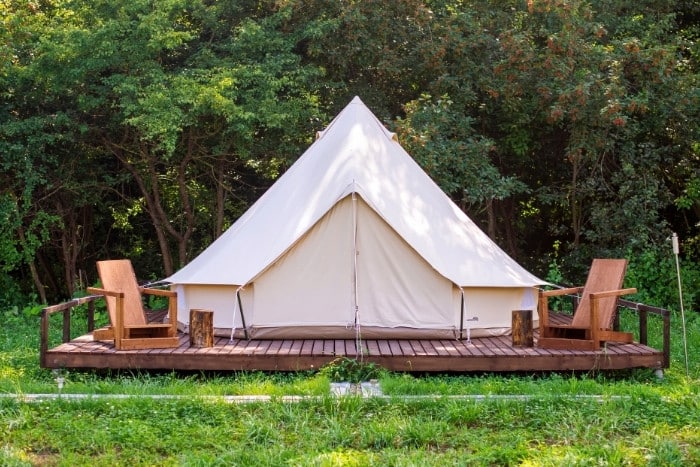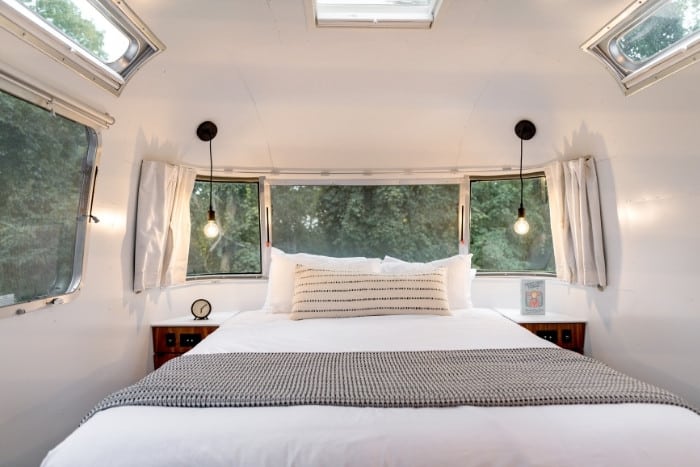As with traditional camping, there are plenty of different types of glamping. This abundance of choice is beneficial when it comes to finding something that suits your style at a reasonable price. However, it can be easy to get lost among all the options and technical terminology.
Tents, spacious yurts and teepees, villas and nature lodges, eco-pods, and even the adventurous treehouse or igloo are just some of the different kinds of glamping options available. Glamping can provide 5-star stays deep in the wilderness and offer a sustainable and luxurious getaway.
Those are just a few examples, with many others for you to explore. To make things easier, we’ve provided a breakdown of the different types of glamping being enjoyed all over the globe.
Types of Glamping
Here, we’ve covered the six main categories of glamping accommodation, with examples, to give you an idea of what’s out there.
Read on to discover which best suits your needs and to find some handy inspiration for your next glamping trip.
1. Tent Glamping
When it comes to glamping in a tent, you shouldn’t expect the type that folds up neatly and fits in a backpack or the trunk of your car.
You won’t be dealing with poles and stakes.
Typically, glamping tents are robust, permanent structures more akin to a room you may find in your house or apartment, albeit with fabric walls.
When glamping first took off in the U.K. at the turn of the 21st century, the most common accommodation you’d find was the Mongolian-style yurt: a circular, wooden-framed structure that could be retrofitted with modern conveniences such as plumbing, heating, and electrical outlets.
Recent years have seen the introduction of other types of tents.
The Native American-inspired tepee is a popular choice for glampers, although it is typically smaller than a yurt.
Safari tents have roots in one of the earliest forms of glamping as their size makes them ideal for European and American travelers visiting Africa as early as the 19th century.
In contrast, modern bell tents combine the size, shape, and style of all of the above.

2. Luxury Glamping
Jumping straight to the other end of the glamping spectrum, luxury glamping is slightly harder to define.
While not the same as staying in a hotel or resort, it could be argued that some luxury glamping accommodation is too far removed from its camping roots to earn its moniker.
However, we’d counter that glamping is all about your proximity to nature, no matter how comfortable you are.
Sprawling rustic villas and nature lodges can provide what is essentially a resort in the wilderness and can be constructed from wood or stone or more conventional building materials.
It’s not uncommon to find such accommodation kitted out with fancy amenities such as hot tubs, swimming pools, and gyms.
Luxury glamping is not within everyone’s budget, but it’s the perfect way to experience the benefits of camping without sacrificing any 5-star comforts.
3. Treehouse Glamping
Thanks to the movies, nearly every kid has dreamed of living in their very own treehouse, high up within the forest canopy, at some point in their life.
A few may have even been fortunate enough to build their own in their backyard or local woods.
Luckily, treehouses have become a staple of the glamping world for those who still feel that childlike wonder at the thought of a home among the treetops.
For those who aren’t as keen on heights, stilted cabins allow you to be amongst the leaves and branches without worrying about being too far away from terra firma.
If you don’t mind the altitude, it’s entirely possible to find treehouses built around vast trunks and suspended high above the ground, and even treehouse resorts with each platform linked by sturdy rope bridges.
As with most of the entries within this article, the quality and modernity of these treehouses can vary massively – from rustic rooms with basic amenities to luxury airborne chalets that wouldn’t be out of place at ground level.
4. Eco-Pod Glamping
One of the key reasons camping and glamping have both seen a huge boost in popularity in recent years is our increased desire to holiday more sustainably, and eco-pods are undoubtedly the best way to achieve this.
From the outside, an eco-pod may appear to be a simple cabin. However, there’s more than meets the eye in its construction.
Eco-pods are built solely using sustainable, natural products that have been produced in a way that has as little environmental impact as possible – they may even use completely recycled materials.
The power in these pods will come from renewable energy sources (typically solar), will be well-insulated, and any appliances will have high energy efficiency ratings.
Again, eco-pods come in many different shapes and sizes, including dome and bubble pods that eschew the typical log-cabin aesthetic.
Whichever option you pick, you’ll know you’re minimizing your carbon footprint and doing your part to live sustainably.
5. Mobile Glamping
As with traditional camping, it’s completely possible to glamp on the go by choosing a high-end recreational vehicle for your trip.
With its sleek, mirror-like aluminum exterior, the iconic Airstream trailer looks just as futuristic as the day the brand launched more than eighty years ago.
However, models have been updated for modern needs.
If you’re planning on buying your own high-end RV, base costs can run into the hundreds of thousands, so it may be more prudent to rent one for a week or two instead.
Many glamping sites have repurposed recreational vehicles as static accommodation to offer a greater range of modern luxuries.
Colorful bow-top caravans (colloquially known as gypsy caravans) have made a huge comeback in recent years, and converted buses have been showing up more and more frequently.

6. Alternative Glamping
Finally, we come to the weird and wonderful world of alternative glamping: accommodation that’s too hard to place in any one category but guarantees a unique experience that you’ll be unlikely to forget.
For millennia, humans have found shelter in caves across the world.
In some locales, such as the Andalucía region of Spain and parts of Italy, these cave houses are still in use and available to rent, albeit with a modern upgrade.
If you prefer colder climes over the heat of southern Europe, you can book a trip to the Alps or northern Scandinavia and hole up in your own igloo.
Suppose you’re not sold on the idea of traditional solid-ice construction.
In that case, it’s entirely possible to find modernized hybrids with insulated glass panels that provide stunning views day and night.
Lastly, fantasy fans will be delighted to know they can live out their Lord of the Rings fantasies in their very own Hobbit Hole (alternatively known as Halfling Houses or Glamping Burrows).
These are dug deep into luscious green hillsides and come with their very own circular doors.
There’s no word on whether you can expect a visit from any dwarves or wizards yet, but you won’t know unless you give one a try.
Conclusion
Over the past fifteen years, glamping has continued to be one of the fastest growing types of holiday in the travel market, with novel types of glamping springing up everywhere, all the time.
With an ever-increasing amount of choice, glamorous camping has not only become more affordable.
Still, it continues to provide many options to suit your preferred style of outdoor accommodation.
